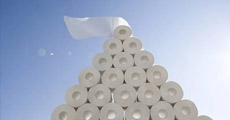Bamboo pulp paper is getting more and more popular in China due to its healthier and more environment-friendly characteristics. Here are the main differences between bamboo pulp paper and wood pulp paper:
1. Different raw materials
Wood pulp paper generally refers to the paper made of high quality wood as raw material, which is made by beating pulp, cooking and other processes, with fine paper, soft, smooth surface and good toughness. The paper towels made of inferior base paper are rough, loose, porous, and poor expansion intensity, resulting in paper scraps and paper hair left at the wiping place, affecting the use of paper. In addition, the color of tissue made of inferior base paper is not white enough, which often results in excessive use of fluorescent brightener.
Bamboo pulp paper is produced by using bamboo pulp alone or with wood pulp and straw pulp with reasonable proportion through pulping and rinsing and other paper-making processes. The performance of bamboo pulp is between coniferous wood and broadleaved wood, which is obviously superior to that of grass. Pulp, can replace broad-leaved wood pulp and reduce the amount of coniferous wood pulp, used to make a variety of paper, including a variety of high-grade paper products.
2. Bamboo pulp paper is softer
People who are used to bamboo pulp paper know that wood pulp paper is rough. Because the wood pulp itself is relatively loose and rough, the paper holes produced are sparse and many empty, and the expansibility is poor. The drag will leave paper scraps and small fibers, and the long-term use is not friendly to the respiratory tract. The bamboo fiber is flexible and fine, and the paper is more soft and delicate, without paper scraps, which will not cause allergy.
3.Bamboo pulp paper is stronger and more tear resistant
The ordinary wood pulp paper will be damaged once it is touched with water, and the scraps of paper will stick everywhere. Bamboo pulp paper will not leave paper scraps after wiping, even if the whole paper is soaked in water, it can resist pulling to a certain extent, and will not easily break.
4.Bamboo pulp paper is more environment-friendly and biodegradable
Wood pulp paper-making will consume a lot of forest resources. The total amount of wood consumed in papermaking is 10 million cubic meters per year, which can fill the whole west lake. Forest regeneration is very slow, which leads to the consumption of more forest resources. Bamboo grows very fast. The fastest bamboo can be made into bamboo in only two months, and can be regenerated within three years after cutting. It is a recyclable paper-making material.
As a regenerated cellulose fiber; bamboo fiber is 100% made from bamboo through a high-tech process. The raw material bamboo is well-selected from non-polluted regions in Yunnan and Sicuan Province, China. They are all 3-4 years old new bamboo, of good character and ideal temper. The whole distilling and production process is a relatively green process without pollution. China is the country with the most abundant bamboo resources in the world. In terms of plantation area, China's bamboo forest area is about 5.5 million Hm2, ranking the first in the world. In terms of species, there are 48 genera and more than 500 species of bamboo in China. Among them, small miscellaneous bamboo, Moso bamboo, Dayuan bamboo and depigmentated bamboo are commonly used in the paper industry, which are widely distributed in Sichuan, Jiangxi, Zhejiang and other provinces.
5. Bamboo pulp papers are more bacteriostatic and healthier.
It is a common fact that bamboo can thrive naturally without using any pesticide. Scientists found that bamboo owns a unique anti -bacteria and bacteriostatic bio-agent named "bamboo Kun". This substance is combined with bamboo cellulose during the process of being manufactured into bamboo fiber. Under the microscope, you can find out that the bacteria on the wood pulp paper will rapidly reproduce, while the bacteria on the bamboo pulp paper will not only not reproduce, but also die 72% within 24 hours. This is because the "bamboo Kun" in bamboo is a natural bactericidal component, which can prevent insects and stink, inhibit the growth of bacteria and protect the environment naturally.
Bamboo fiber has particular and natural functions of anti-bacteria, bacteriostatic and deodorization. It is validated by Japan Textile Inspection Association that even after fifty times of washing bamboo fiber fabric still possesses excellent function of anti-bacteria. Its test result show over 70% elimination rate after bacteria being incubated on bamboo fiber fabric.




















